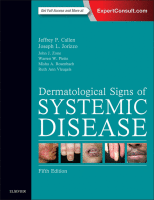Physical Address
304 North Cardinal St.
Dorchester Center, MA 02124

Key Points Several porphyrias share similar photocutaneous features; sufficient testing to assure correct diagnosis must precede selection of therapies. Most porphyrias can be correctly diagnosed biochemically. Mutation analysis is the gold standard for porphyria diagnosis and family counseling. Clinical and…

Key Points Classic signs of excess cortisol (Cushing’s) include moon facies, striae, atrophy, and acne. Cortisol deficiency (Addison’s) presents with hyperpigmentation of the skin, nails, and mucous membranes. Excess androgens, as seen in polycystic ovary syndrome and congenital adrenal hyperplasia,…

Key Points Cutaneous xanthomas present as yellow papules, nodules, or plaques and can signal the presence of an underlying lipid, metabolic, or hematologic abnormality. Xanthelasma is the most common cutaneous xanthoma and can be seen in association with dyslipoproteinemia in…

Key Points When evaluating cysts and nodules of the head and neck, consider thyroglossal ductal cysts and thyroid carcinoma metastases. There are many syndromes associated with thyroid cancer with dermatologic manifestations (e.g., Cowden’s disease, multiple mucosal neuroma syndromes, Gardner’s syndrome,…

Key Points Diabetes mellitus (DM) is a highly prevalent, chronic, multisystem disease that affects the skin at some point of the disease in up to 70% of affected individuals. Although the etiology is often unknown, the pathogenesis of many cutaneous…

Key Points A variety of vascular lesions can serve as cutaneous signs of systemic disease. Telangiectasias or angiokeratomas with particular morphologies and distributions raise suspicion for an autoimmune connective tissue disease or a genetic disorder. Vascular anomalies are divided into…

Key Points Langerhans cell histiocytosis (LCH) is a clonal neoplastic disorder. LCH represents a spectrum of disease from asymptomatic skin-limited self-resolving lesions to systemic multisystem disease with high mortality. The majority of LCH cases harbor the BRAF V600E mutation, suggesting…

Key Points The presence of a monoclonal gammopathy may be an incidental finding, but there are many cutaneous disorders that are due to or are strongly associated with the presence of a monoclonal gammopathy. A usual way to organize thinking…

Key Points Cutaneous lymphomas represent a heterogeneous group of malignant lymphomas arising primarily in the skin. Most cutaneous lymphomas are listed as separate entities in the World Health Organization classification of hematologic malignancies. Differentiation of primary cutaneous lymphomas from extracutaneous…

Key Points Cutaneous metastases are not uncommon, and are usually a late finding with poor prognosis. Cutaneous metastases can be the first sign of an internal malignancy or of extranodal disease in a known malignancy. Breast cancer is the most…